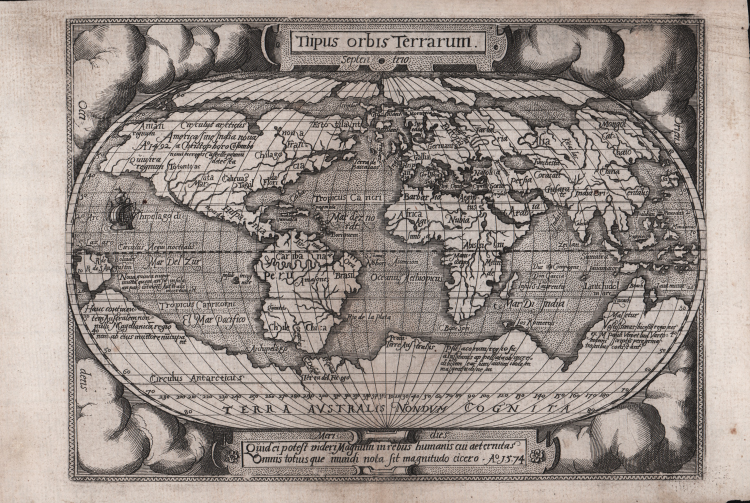



| Reference: | S339120 |
| Author | Abraham ORTELIUS - Philip GALLE |
| Year: | 1583 |
| Zone: | The World |
| Printed: | Antwerpen |
| Measures: | 219 x 161 mm |


| Reference: | S339120 |
| Author | Abraham ORTELIUS - Philip GALLE |
| Year: | 1583 |
| Zone: | The World |
| Printed: | Antwerpen |
| Measures: | 219 x 161 mm |
Fine example of Philippe Galle's rare map of the World, engraved for the first edition of his Spieghel del Werelt, the first miniature edition of Ortelius' Theatrum Orbis Terrarum.
This map is a neatly-engraved smaller copy of Ortelius' first world map plate, published in 1570, that is the first map of the Theatrum Orbis Terrrarum (Shirley, 122; Koeman, Ort 1; Karrow: 1/6, van der Krogt AN: 0001:31A).
The Galle's plate is dated 1574 although the first printing of Galle's atlas did not taken place until 1577. The motto below the map is a quotation from Cicero (Tusculanae Disputatianes IV. 1 7. 37) Quid ei potest videri magnum in rebus humanis, cui aeternitas omnis, totiusque mundi nota sit magnitudo (For what human affairs can seem important to a man who keeps all eternity before his eyes and knows the vastness of the universe?). The worl map published by Galle is larger that the other maps in the atlas.
The cartographic sources for the Ortelius world map are: Gerard Mercator's 1569, Gastaldi's 1561 world map and Diego Gutierrez' portolan map of the Atlantic. The oval shape goes back to Apianus and/or Bordonius. The world map by Ortelius, signed by Franciscus Hogenberg, is first one occurring in the first regular atlas the "Theatrum Orbis Terrarum", so the map is of fundamental importance in the history of cartography.
This map appeared only in the earliest editions of Ortelius' Epitome, published between 1577-1585 - and from 1588 was replaced by the much smaller Typus Orbis Terrarum.
Shirley quotes the rarity fo this map as "S" (Scarce).
Map published taken from the second French edition of ‘Le Miroir du Monde’, published by Galle & Heyns in 1583, printed by Plantin. Le Miror du Monde is the French transaltion of the Duch poems Spieghel der Werelt, the first modern pocket-atlas, published by Philip Galle with text by Peeter Heyns in 1577, based on Abraham Ortelius’
Theatrum Orbis Terrarum. The maps were drawn and engraved by Galle.
Two years later, in 1579, Galle & Heyns published the first French edition: Heyns translated the Dutch poems into French prose because he did not find time to put them into rhyme. This French edition became very popular and in 1583 an amplified reprint appeared.
Galle & Heyns published 5 French edition, two with the title Miroir, and three (1588, 1590, 1598) with the title Epitome du thétre du Monde d’Abraham Ortelius, that appeared from 1588 onwards (Peeter Heyns’ name no longer figures on the title pages of the Antwerp editions).
Second French edition of this rare miniature atlas, "enlarged with eleven maps... six are double sized" (Koeman p. 275).
Compared to the first edition of 1579, which contained 72 maps, the second edition was increased by 11 new maps, for a total of 83 plates.
Between 1577 & 1598 Galle issued 11 editions, all printed by Christopher Plantin.
|
Shirley, 132; Koeman, Ort 47
|
Abraham ORTELIUS - Philip GALLE (Haarlem, 1537 - Anversa, 1612)
|
Draughtsman, engraver, publisher, print dealer, writer and historian. It is possible that he was a pupil in Haarlem of Dirk Volkertsz. Coornhert, but more than likely he was trained in the Antwerp workshop of Hieronymous Cock, who published Galle’s first prints in 1557 and for whom he worked for many years. Shortly after 1557 Philip Galle started his own publishing and print business, for which he travelled extensively: in 1560–61 he visited the southern Netherlands, France, Germany and Italy. After 1564 he settled in Antwerp, where he acquired citizenship in 1571, the same year in which he became a master in the city’s Guild of St Luke. He served as dean of the guild from 1585 to 1587. His documented pupils were H. van Doort in 1580, Karel van Mallery (1571–1635) in 1586, Jean-Baptiste Barbé (1578–1649) in 1594 and Peter Backereel (d 1637) in 1605. Others working at the workshop and publishing house included Philip’s sons Theodor and Cornelis, his son-in-law Adriaen Collaert, pupils van Mallery and Barbé, the Wierix brothers, Hendrick Goltzius, Crispijn de Passe I and other members of the Collaert family.
|
|
Shirley, 132; Koeman, Ort 47
|
Abraham ORTELIUS - Philip GALLE (Haarlem, 1537 - Anversa, 1612)
|
Draughtsman, engraver, publisher, print dealer, writer and historian. It is possible that he was a pupil in Haarlem of Dirk Volkertsz. Coornhert, but more than likely he was trained in the Antwerp workshop of Hieronymous Cock, who published Galle’s first prints in 1557 and for whom he worked for many years. Shortly after 1557 Philip Galle started his own publishing and print business, for which he travelled extensively: in 1560–61 he visited the southern Netherlands, France, Germany and Italy. After 1564 he settled in Antwerp, where he acquired citizenship in 1571, the same year in which he became a master in the city’s Guild of St Luke. He served as dean of the guild from 1585 to 1587. His documented pupils were H. van Doort in 1580, Karel van Mallery (1571–1635) in 1586, Jean-Baptiste Barbé (1578–1649) in 1594 and Peter Backereel (d 1637) in 1605. Others working at the workshop and publishing house included Philip’s sons Theodor and Cornelis, his son-in-law Adriaen Collaert, pupils van Mallery and Barbé, the Wierix brothers, Hendrick Goltzius, Crispijn de Passe I and other members of the Collaert family.
|